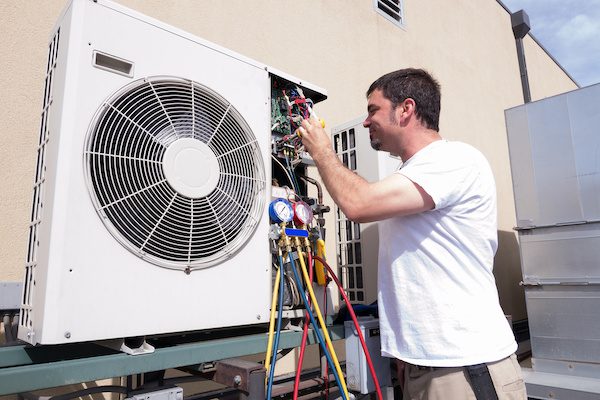
How to Choose the Right HVAC System From Your Contractor
In the United States, roughly 6% of all energy use goes toward powering air conditioning systems. No matter what part of the country you live in, an effective HVAC system is critical to keeping your home at a comfortable temperature.
COMPARE COSTSIf you’re considering a new HVAC system, it may be because you’re replacing an old one, building a new home, or installing a different type of system. Whatever the case, choosing an HVAC system from all the different options can be overwhelming.

This article will give an overview of the different types of HVAC systems and what factors to consider when choosing one. Read on to learn everything you need to select an HVAC system!
What Exactly Is an HVAC System?
HVAC stands for “heating, ventilation, and air conditioning.” Your HVAC system allows you to control the temperature in your home.
Several components make up the system, depending on what type of HVAC system you have. Generally, an HVAC system combines a furnace, cooling unit, and air ducts.
In some cases, a system may not include all of these components. For example, some systems use multiple units and no ductwork, and others may use a boiler instead of a furnace.
Understanding the HVAC System Types
There are many types of heating and air conditioning equipment, but they all fall into one of these four broad categories:
- Split system
- Hybrid system
- Ductless mini-split
- Packaged system
Which of these types of HVAC systems is suitable for you depends on several factors, such as your budget and the layout of your home. Let’s examine each type of system in detail.
Split System
Split HVAC systems are by far the most common in the United States. A system is “split” when it uses two units, one indoors and one outside the home.
The indoor unit removes heat from the air inside and transfers it to the outdoor condenser to cool a home. The condenser, usually on a cement slab in the backyard, then expels the heat outside.

The most common type of split HVAC system is the central system, which circulates warm or cool air through a system of air ducts.
Another less common option for split systems is a heat pump system. Heat pumps cool and heat homes by transferring heat between the outside and inside air rather than with a furnace and compressor.
Hybrid System
A hybrid split system, technically a subcategory of the split system, uses an outdoor condenser and an indoor unit. Hybrid systems differ, however, in that they use a combination of heat sources to increase energy efficiency.
For example, most split systems use natural gas, electricity, or boilers for heat. On the other hand, a hybrid system uses a combination of two or more heat sources to save homeowners money on energy costs.
Most often, hybrid systems alternate between electric and natural gas heat throughout the day. Hybrid systems also typically require ductwork.
Ductless Mini-Split
Not all homes are suited for air ducts, but many still need to heat and cool multiple rooms. If this is the case for your home, you most likely want a ductless mini-split system.
Similar to a split system, a mini-split also uses an indoor unit and an outdoor condenser. However, rather than a system of air ducts, mini-split systems use multiple indoor units to heat and cool rooms.
Mini-splits are an excellent choice for older homes with thin walls or even apartments. However, keep in mind that indoor units typically need to be mounted to an exterior wall to connect to the condenser outside.
Running all the necessary indoor units can be expensive for larger homes with many rooms. However, mini-splits are often more cost-effective for a smaller house than systems with air ducts.
Packaged System
A packaged system combines the heater, air conditioner, and condenser into one large outdoor unit. HVAC professionals usually install the packaged system outdoors on the roof or in the backyard for most homes.

Packaged systems are a good choice for homes with limited indoor space for equipment. For example, homes without attics or basements may benefit from this kind of system.
The packaged system connects to your air ducts and thermostat through one hole in an exterior wall.
While there are several benefits to packaged systems, they are exposed to the elements outdoors. As a result, they tend to run into more maintenance problems and shorter lifespans than other systems.
COMPARE COSTSOther HVAC Systems
In addition to the four main types of HVAC systems, there are a few less conventional options that may also be a good fit for you.
A geothermal system, for example, is a relatively new type of HVAC system. Rather than moving heat from the air, it pulls heat from deep in the ground or nearby bodies of water.
Geothermal systems are remarkably energy efficient, but they aren’t suitable for locations with extremely hot or cold weather. Instead, this type of system is best for areas with a mild climate.
On the other hand, you may only need one or two rooms heated and cooled, or only for a few months out of the year. If that’s the case, your home may only need portable or window air conditioners.
Because you can quickly set these up yourself, standing or window units are a good choice for small homes in temperate areas.
Learning How to Choose an HVAC System
When getting quotes from an HVAC contractor, try to get as much information about your HVAC options as possible. There are many factors you should consider, and it’s essential to research all of them.
Thinking about these factors when you choose an HVAC system will help you save money on the following:
- Installation cost
- Energy costs
- Maintenance and repair costs
Additionally, and most importantly, making the right choice will allow you to keep your home at a comfortable temperature year-round.
Consider the Location
This may be the most critical factor in determining the right HVAC system for your home.
Think about how warm and cold it gets throughout the year. How much heating and cooling power does your system need to provide?
You also need to consider the geography of your home in terms of how it affects installation. For example, some systems require a large amount of land around the house and aren’t suitable for homes close to neighbors.
Think About Your Home Design
The style of your home also dramatically affects the type of HVAC system you can install. Many older homes have walls too thin for the installation of ductwork.
While you can hire professionals to reframe your home for ductwork, it can be costly if it requires significant rebuilds. You may be better off going with a ductless mini-split.
For a ductless mini-split, consider how your home is laid out, where the exterior walls are, and how many rooms need cooling. All these will help you determine if the cost of a mini-split is worth it.
Luckily, most homes in the United States already have ductwork. If this is the case, replacing your HVAC system can be a much simpler and cheaper process.
What About the Noise Levels?
Excessive noise can be a problem for homes with standing or packaged units. A benefit of split systems is the noisiest part (the condenser) is outside, where you won’t hear it as much.
Ask an HVAC professional about how much extraneous noise a system makes. You may not need such a powerful system, and you can get a quieter one that will be just as effective.
In addition to your own noise tolerance, you should find out if there are any HOA requirements for HVAC noise levels in your neighborhood.
Understanding SEER
This is one of the most critical factors for your HVAC system’s operating cost (the amount it costs over time to run your system).
The SEER, or seasonal energy efficiency ratio, measures a system’s energy efficiency, shown as a number between 13 and 27. The higher the number, the less energy a unit uses for the same amount of heating and cooling.
Some states have minimum SEER ratings that are higher than others, so be sure to research your local regulations. A 15 SEER is considered good, so try to use this as a minimum guideline.
A system with a high SEER can save you money on your energy bills and be more environmentally friendly. They also tend to provide more consistent temperature control since they don’t power cycle as often as systems with a lower SEER.
BTU
Another number you’ll want to consider carefully is a system’s BTU (British Thermal Unit). This unit measures how much cooling or heating a unit provides.
Residential HVAC BTUs can range anywhere from 18,000 to 60,000.
The BTU that’s appropriate for your home depends on a few different things, but a good rule of thumb is that an air conditioner should provide 20 BTU per square foot of space. As well as square footage, other factors that affect how much BTU your HVAC system needs include:
- Ceiling height
- Insulation
- Number of windows and doors
- Local climate and humidity
When you have a technician inspect your system, ask for an estimate of the minimum BTU rating for your house. You can use an online calculator, but these tend to only factor in square footage. A licensed technician will consider many factors to give you an accurate estimate.
What Type of Fuel Does the System Use?
Heating and cooling equipment can use one of several different fuel types or even a combination of two or more.
Heaters and furnaces can run on electricity, natural gas, propane, or even oil to generate heat. Many homes are turning toward solar power as well.
Depending on where you live, some of these options may be considerably cheaper than others. On the other hand, the cost of installing more efficient systems is usually higher, so consider your budget.
The type of fuel your system uses impacts not only the cost but also the system’s capacity and environmental impact.
How Much Does the System Cost?
Finally, you have to choose a system that’s within your budget. There are two costs to consider: installation cost and operation cost.
The installation cost is the total you’ll pay to install the system. This includes the cost of the equipment, labor, and materials.
On the other hand, you have operation costs, which are the recurring expenses associated with running your system. Installation costs include utility bills, maintenance, and repairs.
Some systems may have a higher installation cost but can save enough money in the long term to outweigh the upfront expense. Other systems may look like a good deal at first but end up costing you more over time.
Be sure to decide on a budget when you start shopping for systems. Once you know how much you’re willing to spend, you can narrow down your options to ones that fit within your budget.
Find the Perfect System for Your Home Today
When you’re getting ready to replace your HVAC system, the number of options available may be daunting.
To make the right choice for your home, keep in mind where you live, your home’s layout, and your energy requirements. Then, use the system’s BTU and SEER ratings to help inform your decision.
If you aren’t sure which contractor you should use, HVAC Service Cost can help. Our team brings 25 years of HVAC experience to homeowners across the nation.
Contact us today to learn more about how we can pair you with the perfect HVAC contractor!
COMPARE COSTS


Leave a Reply